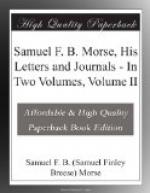The name of Cyrus Field naturally suggests the Atlantic Cable, and it was just at this time that steps were being seriously taken to realize the prophecy made by Morse in 1843 in his letter to the Secretary of the Treasury: “The practical inference from this law is that a telegraphic communication on the electro-magnetic plan may with certainty be established across the Atlantic Ocean! Startling as this may now seem I am confident the time will come when this project will be realized.”
In 1852 a company had been formed and incorporated by the Legislature of Newfoundland, called the “Newfoundland Electric Telegraph Company.” The object of this company was to connect the island by means of a cable with the mainland, but this was not accomplished at that time, and no suggestion was made of the possibility of crossing the ocean. One of the officers of that company, however, Mr. F.N. Gisborne, came to New York in 1854 and tried to revive the interest of capitalists and engineers in the scheme. Among others he consulted Matthew D. Field, and through him met his brother Cyrus W. Field, and the question of a through line from Newfoundland to New York was seriously discussed. Cyrus Field, a man of great energy and already interested financially and otherwise in the terrestrial telegraph, was fascinated by the idea of stretching long lines under the waters also. He examined a globe, which was in his study at home and, suddenly realizing that Newfoundland and Ireland were comparatively near neighbors, he said to himself: “Why not cross the ocean and connect the New World with the Old?” He had heard that Morse long ago had prophesied that this link would some day be welded, and he became possessed with the idea that he was the person to accomplish this marvel, just as Morse had received the inspiration of the telegraph in 1832.
A letter to Morse, who was just then in Washington, received an enthusiastic and encouraging reply, coupled with the information that Lieutenant Maury of the Navy had, by a series of careful soundings, established the existence of a plateau between Ireland and Newfoundland, at no very great depth, which seemed expressly designed by nature to receive and carefully guard a telegraphic cable. Mr. Field lost no time in organizing a company composed originally of himself, his brother the Honorable David Dudley Field, Peter Cooper, Moses Taylor, Marshall O. Roberts, and Chandler White. After a liberal charter had been secured from the legislature of Newfoundland the following names were added to the list of incorporators: S.F.B. Morse, Robert W. Lowber, Wilson G. Hunt, and John W. Brett. Mr. Field then went to England and with characteristic energy soon enlisted the interest and capital of influential men, and the Atlantic Telegraph Company was organized to cooperate with the American company, and liberal pledges of assistance from the British Government were secured. Similar pledges were obtained from the Congress of the United States, but, quite in line with former precedents, by a majority of only one in the Senate. Morse was appointed electrician of the American company and Faraday of the English company, and much technical correspondence followed between these two eminent scientists.




